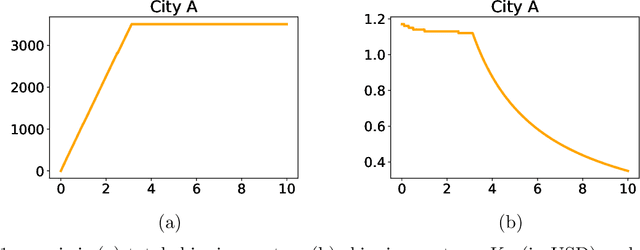Lorenzo Maggi
EMF Exposure Mitigation via MAC Scheduling
Apr 19, 2024



Abstract:International standards bodies define Electromagnetic field (EMF) emission requirements that can be translated into control of the base station actual Effective Isotropic Radiated Power (EIRP), i.e., averaged over a sliding time window. In this work we show how to comply with such requirements by designing a water-filling power allocation method operating at the MAC scheduler level. Our method ensures throughput fairness across users while constraining the EIRP to a value that is produced by an outer-loop procedure which is not the focus of our paper. The low computational complexity of our technique is appealing given the tight computational requirements of the MAC scheduler. Our proposal is evaluated against the prior art approaches through massive-MIMO system level simulations that include realistic modeling of physical and MAC level cellular procedures. We conclude that our proposal effectively mitigates EMF exposure with considerably less impact on network performance, making it a standout candidate for 5G and future 6G MAC scheduler implementations.
EMF Mitigation via 5G and 6G MAC Scheduling
Apr 10, 2024



Abstract:High antenna directivity allows for high throughput transmission but also increases the exposure to electromagnetic field (EMF) of the end-users. Health regulations impose limitations on the incident power density, that generate a negative impact on network performance. In this work we focus at the slot-by-slot operations of a cellular Medium Access Control (MAC) scheduler to constrain the short-term EMF exposure upon real-time resource allocation, minimizing the impacts on network performance. We assume that the long-term EMF exposure is controlled by a proper outer-loop technique, that is not the object of this paper. Due to the minimal computational complexity allowed in MAC scheduling, existing solutions allowing practical implementation are few and focused at sub-optimal approaches curbing radio resource allocation. Our contribution is the derivation of a computationally efficient water-filling solution to allocate power and - then - resources, with a feasible integration of the necessary algorithms in the operations of a 5G MAC scheduler. We finally evaluate our proposal versus the prior art approaches with system level simulations with realistic modeling of physical and MAC level cellular procedures. We conclude that our proposal can control EMF with considerable less impact on network performance, making it a standout candidate for 5G and future 6G MAC scheduler implementations.
Bayesian and Multi-Armed Contextual Meta-Optimization for Efficient Wireless Radio Resource Management
Jan 16, 2023



Abstract:Optimal resource allocation in modern communication networks calls for the optimization of objective functions that are only accessible via costly separate evaluations for each candidate solution. The conventional approach carries out the optimization of resource-allocation parameters for each system configuration, characterized, e.g., by topology and traffic statistics, using global search methods such as Bayesian optimization (BO). These methods tend to require a large number of iterations, and hence a large number of key performance indicator (KPI) evaluations. In this paper, we propose the use of meta-learning to transfer knowledge from data collected from related, but distinct, configurations in order to speed up optimization on new network configurations. Specifically, we combine meta-learning with BO, as well as with multi-armed bandit (MAB) optimization, with the latter having the potential advantage of operating directly on a discrete search space. Furthermore, we introduce novel contextual meta-BO and meta-MAB algorithms, in which transfer of knowledge across configurations occurs at the level of a mapping from graph-based contextual information to resource-allocation parameters. Experiments for the problem of open loop power control (OLPC) parameter optimization for the uplink of multi-cell multi-antenna systems provide insights into the potential benefits of meta-learning and contextual optimization.
Learning Algorithms for Regenerative Stopping Problems with Applications to Shipping Consolidation in Logistics
May 05, 2021



Abstract:We study regenerative stopping problems in which the system starts anew whenever the controller decides to stop and the long-term average cost is to be minimized. Traditional model-based solutions involve estimating the underlying process from data and computing strategies for the estimated model. In this paper, we compare such solutions to deep reinforcement learning and imitation learning which involve learning a neural network policy from simulations. We evaluate the different approaches on a real-world problem of shipping consolidation in logistics and demonstrate that deep learning can be effectively used to solve such problems.
 Add to Chrome
Add to Chrome Add to Firefox
Add to Firefox Add to Edge
Add to Edge